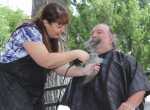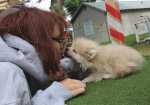Relay promotes effort to find cancer cure

One by one, people stepped onto the designated pathway at Carl Miller Park. Splitting off into two groups, Curtis Carlin led the first procession one way while the second group took the opposite route.
Meeting somewhere around the halfway point, the simple stroll along the gravel pathway was a symbolic gesture of sorts. It represented the struggle that some of these people faced in their battle against cancer and the strength they received from their family and friends that helped them in their fight against the disease.
For the next 12 hours, people from Mountain Home and surrounding communities gathered at the city park to help raise money for cancer research and education during this year's Relay for Life.

"We have survivors, caregivers and friends gathered here today," said organizer Kenda Schroeder as the relay prepared to start.
This year's event saw a noted jump in the number of participants with 26 teams and 409 registered walkers. The teams had already raised $29,972 by the time the relay began Saturday morning with a goal of $36,000 by the end of the event, said relay spokesperson Brandi Garlitz.
"We're hoping to make that goal by the end of the day," Garlitz said.

"I'm very excited this year. We have... teams here raising money for cancer research and programs," said Karen Beisner, staff member with the American Cancer Society, who also serves with the Elmore County Relay for Life organization. "We're knocking it out of the park with all the activities this year, all run by volunteers."
Cancer is very personal to those inflicted with the disease and those who serve as their caregivers, said Beisner, who estimated that one out of every two people in the United States will be directly impacted by cancer. However, researchers have made a tremendous amount of progress in diagnosing and treating the disease, she added.
"One hundred years ago, if you were diagnosed with cancer, it was a death sentence," Beisner said. "Today, the survival rate is 70 percent."
This is why events like Relay for Life are so important both in terms of raising awareness and raising money. More than 70 percent of the money raised during this year's event goes directly toward cancer research and education programs.
"Every dollar and every donor makes a difference," Beisner said.
Two distinct groups of people attended the event and were singled out by the T-shirts they wore through the afternoon and into the evening. The first group wore gray shirts, indicating they were caregivers that provided direct help to members of their family afflicted by cancer.
The others wore purple T-shirts to indicate they were either currently fighting the disease or had overcome the battle and were either in remission or had been considered cancer free.
Among those wearing those purple shirts was Judy Walton, who was part of the Stronger Together Team. The group included nearly a dozen cancer survivors, including Walton herself.
"It's a good cause," said Judy Walton, who was diagnosed with kidney cancer in 2009.
With no treatment available to combat this form of the disease, she's relied on diet, exercise and good friends during her personal fight.
Each person on her team knew someone that had lost someone they loved to cancer.
They included Margaret Stricklan, who lost her brother to lung cancer, which was attributed to his exposure to Agent Orange during the Vietnam War. She then lost her mother to another form of the disease.
In 1981, Stricklan herself was diagnosed with breast cancer but was able to win the fight.
"I've been cancer free for a long time," Stricklan said with a laugh.
One of the youngest cancer surviors that day was Mila Peace. Holding a purple pinwheel in her hands to symbolize her ongoing fight, the four year old blew against the pedals to make it spin.
Mila was diagnosed with a rare form of cancer that took hold in her spinal cord, said her mother, Angie Peace. After 18 months of chemotherapy, the disease hasn't spread and the tumors have stopped growing.
However, the family knows their child's fight is far from over.
Others sharing their stories that day was Bill Wean, who was diagnosed with cancer in 2010. The four-inch tumor doctors discovered came with it some terrible news -- Wean was given just two years to live.
"I'm one of the fortunate ones. I'm cancer free," Wean said.
Looking out to those gathered at the community park that day, he offered some words of encouragement for those fighting a similar battle.
"Keep hope, the cure is coming," Wean said.
At the same time, he urged others in community to step up and help those who lack the support network they need in their fight against cancer.
During the day, teams developed various ways to raise money. The Team Hope camp set up a kissing booth on the north end of the park. As people dropped money in the collection jar, they were treated to kisses from Scrappy, a tiny dog that provided all the kisses that day.
Meanwhile, Harold Booth fulfilled a pledge that afternoon on behalf of his wife, Tammy. He agreed to have his hallmark beard shaved off -- along with his hair -- as part of this year's cancer awareness effort.
Under the steady hands of Gina Doyle from the Upper Cut salon, the whiskers he had continued to grow since 2009 were quickly removed with the hair on top of his head following shortly afterward. The only thing Booth had left was his moustache.
That effort alone brought in nearly $670.
Several minutes later, Beisner herself fulfilled a separate pledge by agreeing to have her hair shaved off if people donated at least $1,000 in additional pledges. It took less than an hour to hit that mark.
This year's Relay for Life celebration included various events throughout the afternoon and into the evening. Many of these activities had a symbolic meaning attached to them.
Among them was the "sweep out cancer" lap, which encouraged members from each team to walk one lap around the track. Some participants carried brooms, many of which were decked out with assortment of decorations.
It was a symbolic gesture aimed at raising hope that one day the disease would be swept away once and for all.
Memories of those who fought against cancer, including those who lost the fight, continued on that evening during the luminaria observance. Surrounding the fireplace in the center of the park were white paper bags, each one bearing the name of a cancer victim or survivor.
Lights inside each paper bag helped lead people around the display as the evening sky darkened.
